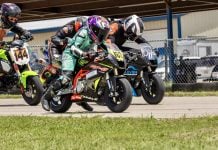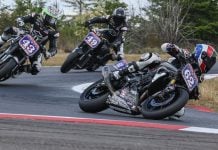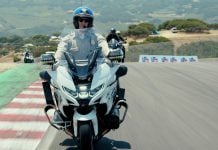Copyright 2002, Roadracing World Publishing, Inc.
By David Swarts
Put this one under the heading of, How AMA Pro Racing Offers Better Service To Justify Increases In License Fees for 2002:
An AMA Pro Competition Bulletin with a Subject line of “Pro Thunder Weight” was sent out December 19, 2001 to clarify rule changes posted for the 2002 season on the AMA Pro Racing website, marking the second time in four months that AMA officials have forgotten the same rule.
Early in the 2001 season, the AMA tried to mandate a 380-pound weight limit for all Pro Thunder class machines. Although the class is made primarily made up of Ducati 748s and Buell 1200s, the category was specifically designed to attract an eclectic mix of machinery brands, sizes, configurations, etc. The Championship has been won in the past by Triumph Triples, Suzuki SV650s have scored podium finishes and the class has played host to other highly-customized, lightweight Twins and single-cylinder machines. The new 380-pound minimum weight requirement would have eliminated everything except Ducatis, Buells and Triumph 900s.
After an uproar from Pro Thunder racers reached AMA Pro Racing, a bulletin was issued before the start of the 2001 season specifying that 600cc – 850cc four-stroke, liquid-cooled, non-desmodromic Twins and four-stroke Singles were exempt from the new minimum weight requirement.
Then at the AMA Pro Thunder race at Virginia International Raceway last September, Chris Normand was wrongly disqualified from his third place finish in the Pro Thunder final for his racebike being underweight despite the fact that Normand rode a Suzuki SV650, a bike that had no minimum weight limit. AMA officials only caught their mistake after reading about it on www.roadracingworld.com in the days following the race and eventually re-instated Normand’s finish.
Then in early December of 2001, the AMA posted the changes to the 2002 road racing rulebook on the official AMA Pro Racing website, www.amadirectlink.com. One of the new rules for 2002 was the inclusion of Pro Thunder machines in the Superstock, a.k.a. 750cc Supersport, class.
As posted on the AMA Pro Racing website:
“Current Rule:
The 750 SuperSport regulations currently do not allow exceptions for twin-cylinder motorcycles to have additional modifications or to be larger in displacement than 750cc.
“Change:
The following displacement limits for twin cylinder four-strokes will be permitted:
600cc-750cc four-stroke liquid-cooled twin cylinders
700cc-1350cc four-stroke air-cooled twin cylinders
Twin cylinder four-strokes will be allowed the same modifications currently allowed in the Pro Thunder class with the exception of tires. The Pro Thunder minimum weight of 380 pounds will apply.”
Pro Thunder racer Tyler Sandell pointed out in a e-mail to Roadracing World, “The problem I have with it is the way it is written, particularly the last line: ‘The Pro Thunder minimum weight limit of 380 pounds will apply.’ I am somewhat confused by this simple verbiage.”
AMA Pro Racing officials realized their mistake and published the Pro Competition Bulletin five days after Sandell’s December 14 e-mail was posted on www.roadracingworld.com.
The AMA Pro Competition Bulletin, dated December 19, 2001, from AMA Pro Racing Technical Manager Rob King reads:
“This bulletin is to clarify the weight limits for Pro Thunder motorcycles.
“The bulletin listing the rule changes for 2002 showed that when entered in Superstock (AMA’s new name for the 750cc Supersport class), Pro Thunder motorcycles had a weight limit of 380 lb. This was taken directly from the 2001 rulebook and is therefore misleading. The 2002 AMA Pro Racing Rulebook listing for the various weight limits in the Pro Thunder class is correct and applies to Pro Thunder motorcycles ridden in Pro Thunder or Superstock. The rulebook reads as follows:
“Minimum weight – 380 pounds – all Pro Thunder motorcycles except the following, which have no weight limit:
(a) Unlimited 4-stroke single cylinders
(b) 600cc – 850cc 4-stroke liquid-cooled twin cylinders (except desmodromic)
“Should you have any questions concerning these changes, please contact Technical Manager Rob King at (614) 856-1910, extension 1230 or Director of Competition Merrill Vanderslice at (614) 856-1910, extension 1262.”
© , Roadracing World Publishing, Inc.












